MAZDA MODEL RX 8 2005 (in English) Service Manual
Manufacturer: MAZDA, Model Year: 2005, Model line: MODEL RX 8, Model: MAZDA MODEL RX 8 2005Pages: 364
Page 41 of 364

Black plate (41,1)
Supplemental Restraint Systems (SRS) Precautions
The front and side supplemental restraint systems (SRS) include up to 6 air bags (verify
“SRS AIRBAG”location indicator marks).
They are located in:
lThe steering wheel hub (driver air bag)
lThe front passenger dashboard (front passenger air bag)
lThe outboard sides of the front seatbacks (side air bags)
lThe front and rear window pillars, and the roof edge along both sides (curtain air bags)
These systems operate independently depending on the type of accident encountered; if
you have side and curtain air bags, the side and curtain air bags are not likely to deploy on
both sides in the same accident because a vehicle is not often hit from both sides. The side
and curtain air bags and the frontal air bag system will not normally deploy during the
same type of accident unless a combination of frontal and side impacts occur.
The air bag supplemental restraint systems are designed to provide supplemental protection
only in the front seats in certain situations and the rear outside passenger positions only in
same-side collisions, so seat belts are always important in the following ways:
Without seat belt usage, the air bags cannot provide adequate protection during an accident.
Seat belt usage is necessary to:
lKeep the occupant from being thrown into an inflating air bag.
lReduce the possibility of injuries during an accident that is not designed for air bag
inflation, such as roll-over or rear impact.
lReduce the possibility of injuries in frontal or side collisions that are not severe enough
to activate the air bags.
lReduce the possibility of being thrown from your vehicle.
lReduce the possibility of injuries to lower body and legs during an accident because the
air bags provide no protection to these parts of the body.
lHold the driver in a position which allows better control of the vehicle.
Children should be protected by a child-restraint system. Laws vary on the size a child
must be to use a child-restraint system (page 2-20).
Carefully consider which child-restraint system is necessary for your child and follow the
installation directions in this Owner's Manual as well as the child-restraint system
manufacturer's instructions.
Essential Safety Equipment
SRS Air Bags
2-29
RX-8_8T69-EA-04G_Edition1 Page41
Wednesday, June 9 2004 2:11 PM
Form No.8T69-EA-04G
Page 42 of 364
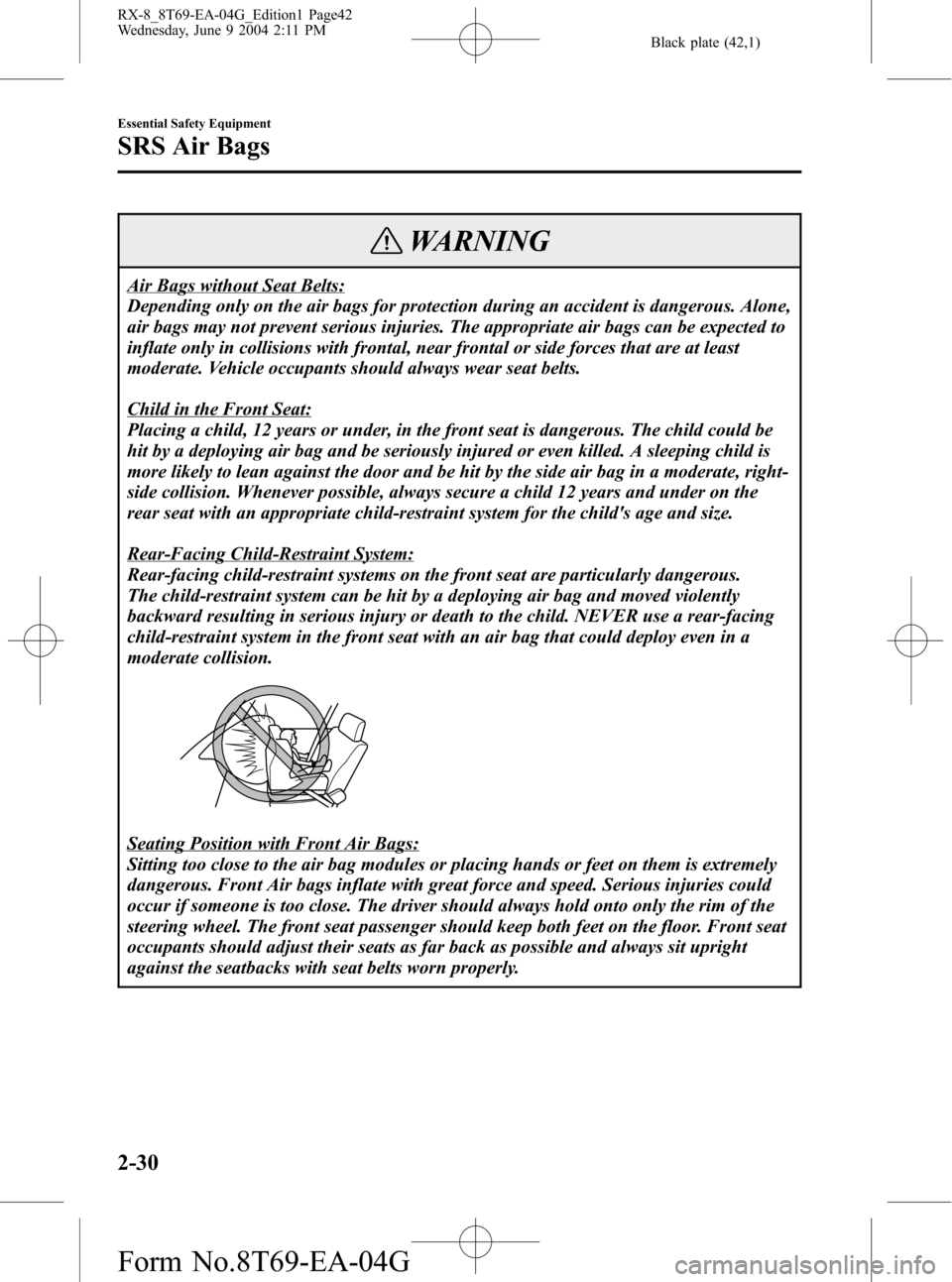
Black plate (42,1)
WARNING
Air Bags without Seat Belts:
Depending only on the air bags for protection during an accident is dangerous. Alone,
air bags may not prevent serious injuries. The appropriate air bags can be expected to
inflate only in collisions with frontal, near frontal or side forces that are at least
moderate. Vehicle occupants should always wear seat belts.
Child in the Front Seat:
Placing a child, 12 years or under, in the front seat is dangerous. The child could be
hit by a deploying air bag and be seriously injured or even killed. A sleeping child is
more likely to lean against the door and be hit by the side air bag in a moderate, right-
side collision. Whenever possible, always secure a child 12 years and under on the
rear seat with an appropriate child-restraint system for the child's age and size.
Rear-Facing Child-Restraint System:
Rear-facing child-restraint systems on the front seat are particularly dangerous.
The child-restraint system can be hit by a deploying air bag and moved violently
backward resulting in serious injury or death to the child. NEVER use a rear-facing
child-restraint system in the front seat with an air bag that could deploy even in a
moderate collision.
Seating Position with Front Air Bags:
Sitting too close to the air bag modules or placing hands or feet on them is extremely
dangerous. Front Air bags inflate with great force and speed. Serious injuries could
occur if someone is too close. The driver should always hold onto only the rim of the
steering wheel. The front seat passenger should keep both feet on the floor. Front seat
occupants should adjust their seats as far back as possible and always sit upright
against the seatbacks with seat belts worn properly.
2-30
Essential Safety Equipment
SRS Air Bags
RX-8_8T69-EA-04G_Edition1 Page42
Wednesday, June 9 2004 2:11 PM
Form No.8T69-EA-04G
Page 43 of 364
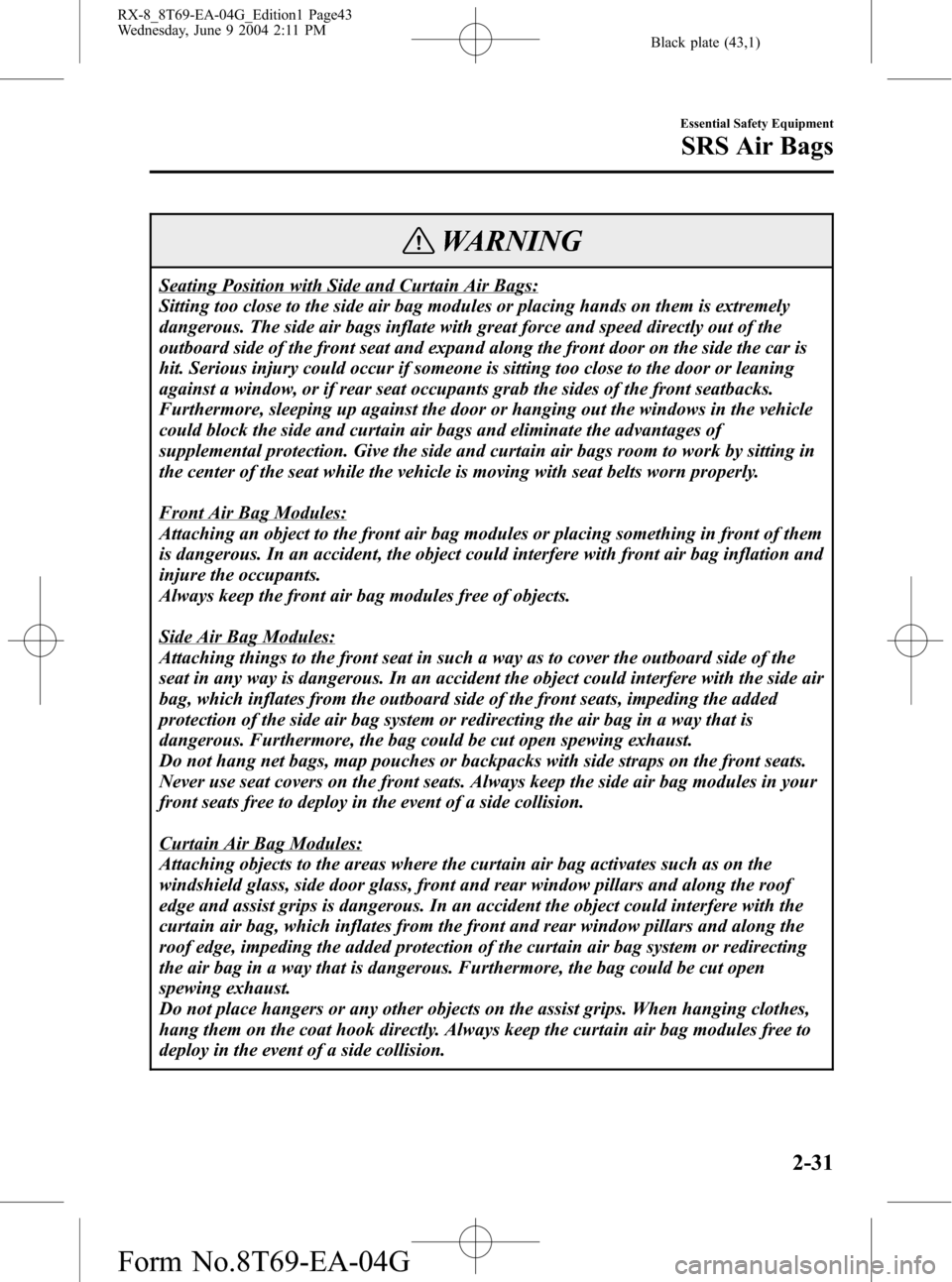
Black plate (43,1)
WARNING
Seating Position with Side and Curtain Air Bags:
Sitting too close to the side air bag modules or placing hands on them is extremely
dangerous. The side air bags inflate with great force and speed directly out of the
outboard side of the front seat and expand along the front door on the side the car is
hit. Serious injury could occur if someone is sitting too close to the door or leaning
against a window, or if rear seat occupants grab the sides of the front seatbacks.
Furthermore, sleeping up against the door or hanging out the windows in the vehicle
could block the side and curtain air bags and eliminate the advantages of
supplemental protection. Give the side and curtain air bags room to work by sitting in
the center of the seat while the vehicle is moving with seat belts worn properly.
Front Air Bag Modules:
Attaching an object to the front air bag modules or placing something in front of them
is dangerous. In an accident, the object could interfere with front air bag inflation and
injure the occupants.
Always keep the front air bag modules free of objects.
Side Air Bag Modules:
Attaching things to the front seat in such a way as to cover the outboard side of the
seat in any way is dangerous. In an accident the object could interfere with the side air
bag, which inflates from the outboard side of the front seats, impeding the added
protection of the side air bag system or redirecting the air bag in a way that is
dangerous. Furthermore, the bag could be cut open spewing exhaust.
Do not hang net bags, map pouches or backpacks with side straps on the front seats.
Never use seat covers on the front seats. Always keep the side air bag modules in your
front seats free to deploy in the event of a side collision.
Curtain Air Bag Modules:
Attaching objects to the areas where the curtain air bag activates such as on the
windshield glass, side door glass, front and rear window pillars and along the roof
edge and assist grips is dangerous. In an accident the object could interfere with the
curtain air bag, which inflates from the front and rear window pillars and along the
roof edge, impeding the added protection of the curtain air bag system or redirecting
the air bag in a way that is dangerous. Furthermore, the bag could be cut open
spewing exhaust.
Do not place hangers or any other objects on the assist grips. When hanging clothes,
hang them on the coat hook directly. Always keep the curtain air bag modules free to
deploy in the event of a side collision.
Essential Safety Equipment
SRS Air Bags
2-31
RX-8_8T69-EA-04G_Edition1 Page43
Wednesday, June 9 2004 2:11 PM
Form No.8T69-EA-04G
Page 44 of 364
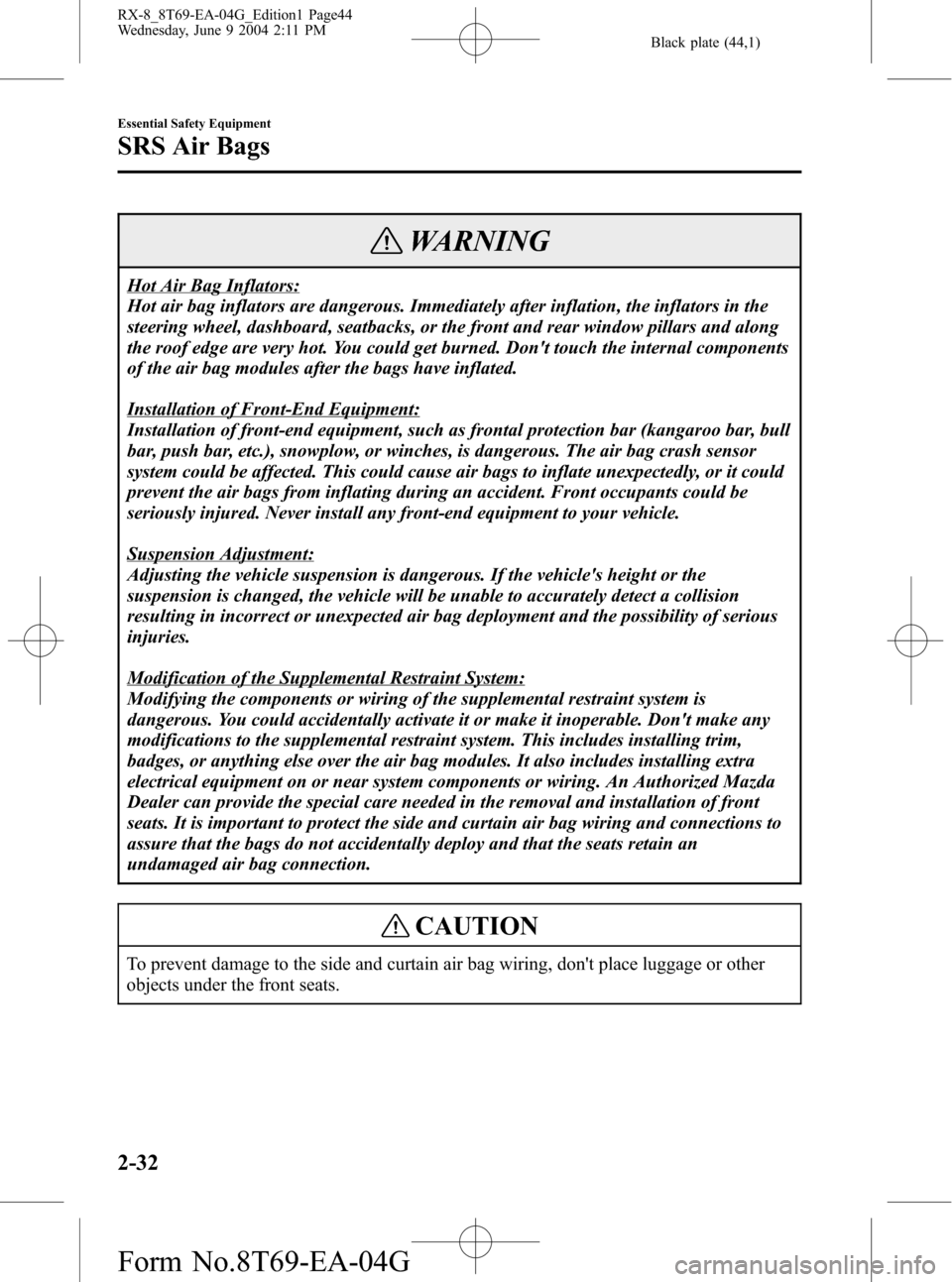
Black plate (44,1)
WARNING
Hot Air Bag Inflators:
Hot air bag inflators are dangerous. Immediately after inflation, the inflators in the
steering wheel, dashboard, seatbacks, or the front and rear window pillars and along
the roof edge are very hot. You could get burned. Don't touch the internal components
of the air bag modules after the bags have inflated.
Installation of Front-End Equipment:
Installation of front-end equipment, such as frontal protection bar (kangaroo bar, bull
bar, push bar, etc.), snowplow, or winches, is dangerous. The air bag crash sensor
system could be affected. This could cause air bags to inflate unexpectedly, or it could
prevent the air bags from inflating during an accident. Front occupants could be
seriously injured. Never install any front-end equipment to your vehicle.
Suspension Adjustment:
Adjusting the vehicle suspension is dangerous. If the vehicle's height or the
suspension is changed, the vehicle will be unable to accurately detect a collision
resulting in incorrect or unexpected air bag deployment and the possibility of serious
injuries.
Modification of the Supplemental Restraint System:
Modifying the components or wiring of the supplemental restraint system is
dangerous. You could accidentally activate it or make it inoperable. Don't make any
modifications to the supplemental restraint system. This includes installing trim,
badges, or anything else over the air bag modules. It also includes installing extra
electrical equipment on or near system components or wiring. An Authorized Mazda
Dealer can provide the special care needed in the removal and installation of front
seats. It is important to protect the side and curtain air bag wiring and connections to
assure that the bags do not accidentally deploy and that the seats retain an
undamaged air bag connection.
CAUTION
To prevent damage to the side and curtain air bag wiring, don't place luggage or other
objects under the front seats.
2-32
Essential Safety Equipment
SRS Air Bags
RX-8_8T69-EA-04G_Edition1 Page44
Wednesday, June 9 2004 2:11 PM
Form No.8T69-EA-04G
Page 45 of 364
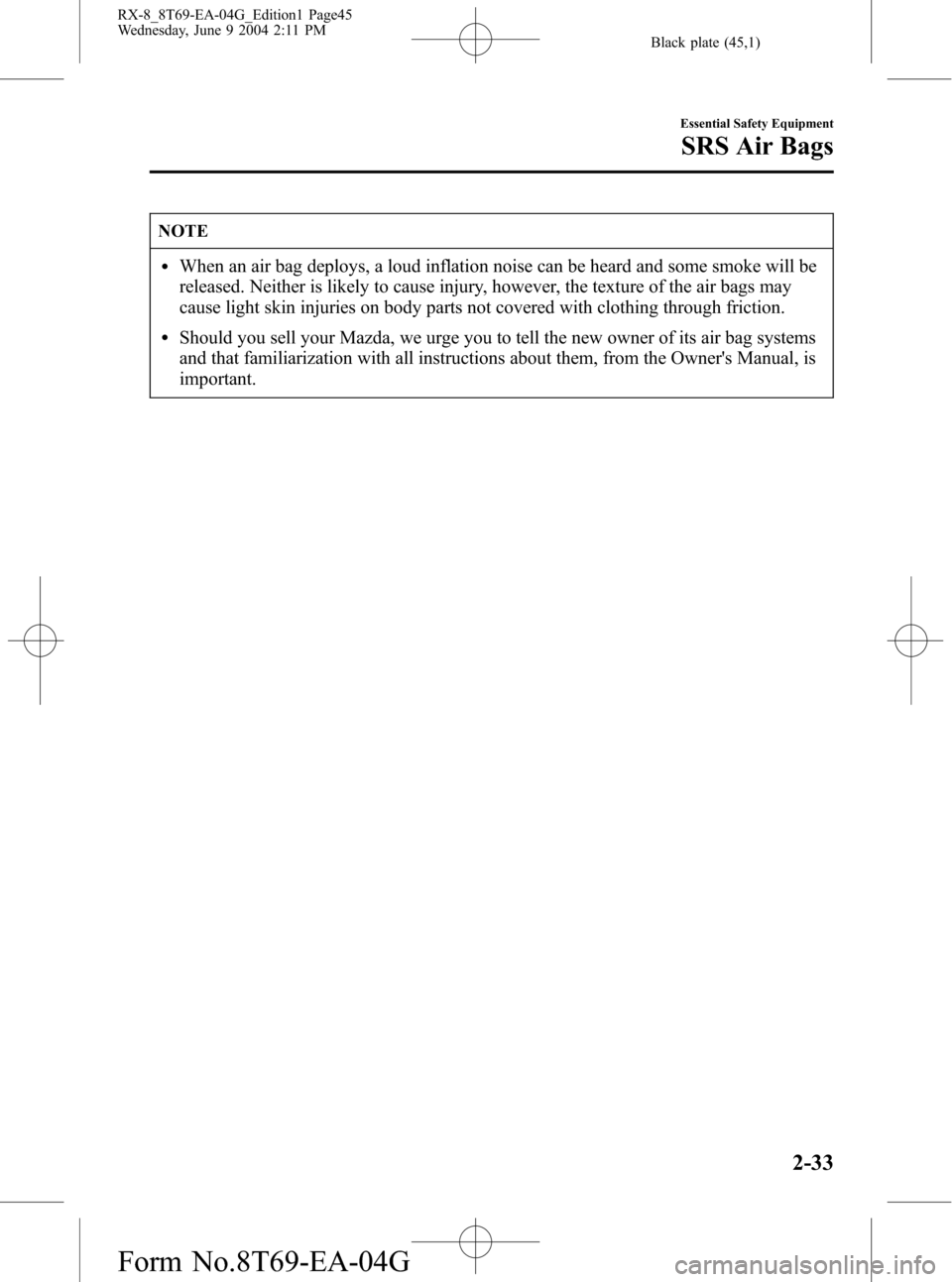
Black plate (45,1)
NOTE
lWhen an air bag deploys, a loud inflation noise can be heard and some smoke will be
released. Neither is likely to cause injury, however, the texture of the air bags may
cause light skin injuries on body parts not covered with clothing through friction.
lShould you sell your Mazda, we urge you to tell the new owner of its air bag systems
and that familiarization with all instructions about them, from the Owner's Manual, is
important.
Essential Safety Equipment
SRS Air Bags
2-33
RX-8_8T69-EA-04G_Edition1 Page45
Wednesday, June 9 2004 2:11 PM
Form No.8T69-EA-04G
Page 46 of 364
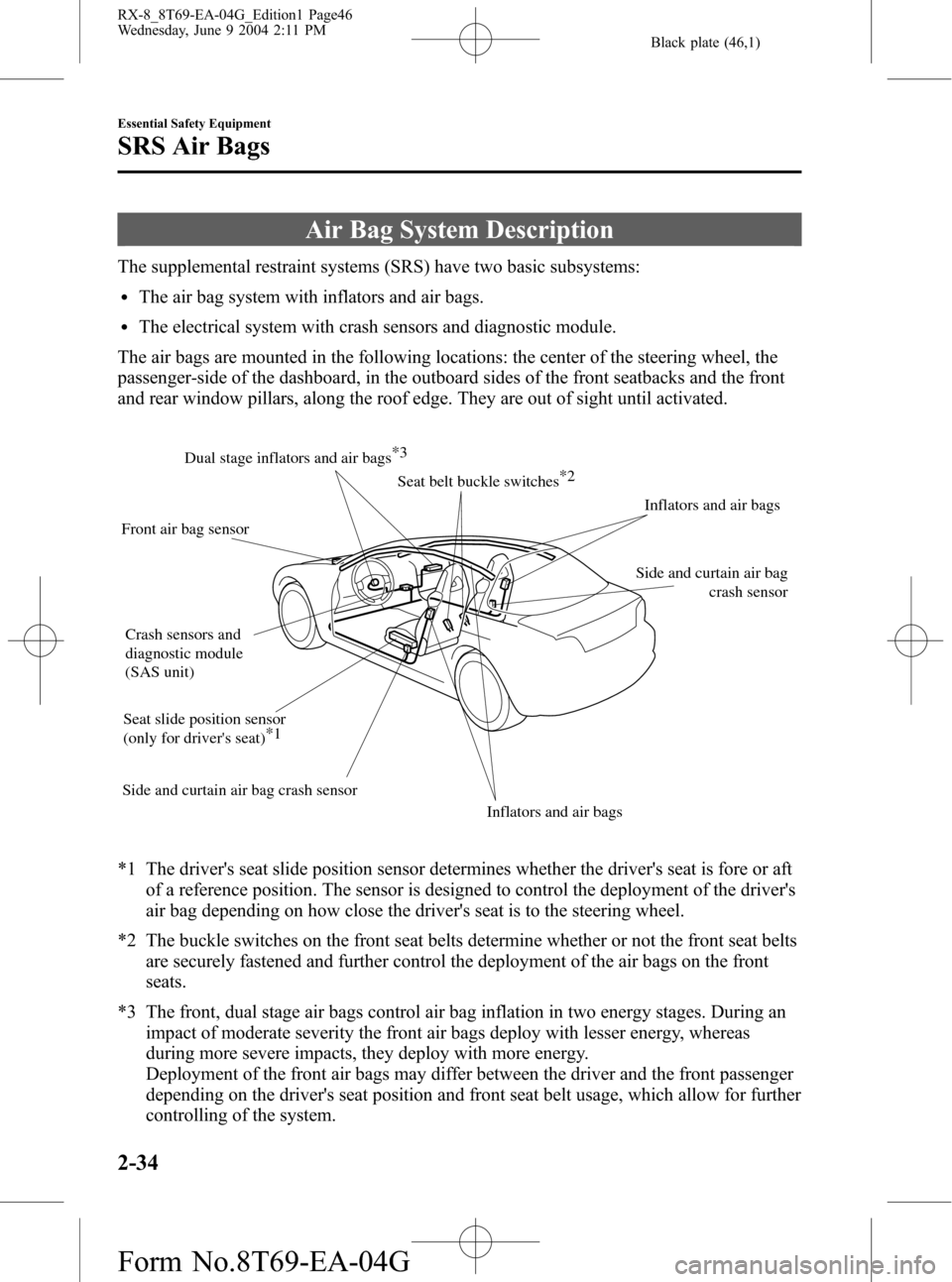
Black plate (46,1)
Air Bag System Description
The supplemental restraint systems (SRS) have two basic subsystems:
lThe air bag system with inflators and air bags.
lThe electrical system with crash sensors and diagnostic module.
The air bags are mounted in the following locations: the center of the steering wheel, the
passenger-side of the dashboard, in the outboard sides of the front seatbacks and the front
and rear window pillars, along the roof edge. They are out of sight until activated.
Dual stage inflators and air bags*3
Seat belt buckle switches*2
Inflators and air bags
Side and curtain air bag
crash sensor
Inflators and air bags Side and curtain air bag crash sensorSeat slide position sensor
(only for driver's seat)*1 Crash sensors and
diagnostic module
(SAS unit) Front air bag sensor
*1 The driver's seat slide position sensor determines whether the driver's seat is fore or aft
of a reference position. The sensor is designed to control the deployment of the driver's
air bag depending on how close the driver's seat is to the steering wheel.
*2 The buckle switches on the front seat belts determine whether or not the front seat belts
are securely fastened and further control the deployment of the air bags on the front
seats.
*3 The front, dual stage air bags control air bag inflation in two energy stages. During an
impact of moderate severity the front air bags deploy with lesser energy, whereas
during more severe impacts, they deploy with more energy.
Deployment of the front air bags may differ between the driver and the front passenger
depending on the driver's seat position and front seat belt usage, which allow for further
controlling of the system.
2-34
Essential Safety Equipment
SRS Air Bags
RX-8_8T69-EA-04G_Edition1 Page46
Wednesday, June 9 2004 2:11 PM
Form No.8T69-EA-04G
Page 47 of 364

Black plate (47,1)
qHow the Air Bags Work
When air bag crash sensors detect a frontal or side impact of greater than moderate force,
an electrical current is sent to the inflators.
Gases are produced to inflate the air bags and after the inflation, the air bags quickly
deflate.
The air bags will function only once. After that,the air bags will not work again and
must be replaced.
Only an Authorized Mazda Dealer can replace the systems.
The front air bags will deploy
only on the frontal impact.
The side air bag will deploy only on the side
the vehicle receives the force of the impact.
The curtain air bag will deploy only on the side
the vehicle receives the force of the impact.
The side and curtain air bags will deploy
together on the same side.
Essential Safety Equipment
SRS Air Bags
2-35
RX-8_8T69-EA-04G_Edition1 Page47
Wednesday, June 9 2004 2:11 PM
Form No.8T69-EA-04G
Page 48 of 364

Black plate (48,1)
qAir Bag Activation/Deactivation
Front air bag activation
A greater than moderate impact will cause
the front air bags to inflate in the
following cases:
lHitting a solid wall straight on at
greater than about 22 km/h (14 mph).
lHitting a curb, pavement edge or hard
object.
lLanding hard or the vehicle falling.
lFrontal impact within about a 30
degree range from head-on to the
vehicle.
lDriving into a big hole or hitting the far
side of a hole.
Limitations to front air bag activation
Depending on the severity of impact, the
front air bags may not inflate in the
following cases:
lImpacts involving trees or poles cause
severe cosmetic damage but may not
have enough impact to activate the air
bag.
lFrontal offset impact to the vehicle
may not provide the stopping force
necessary for air bag deployment.
2-36
Essential Safety Equipment
SRS Air Bags
RX-8_8T69-EA-04G_Edition1 Page48
Wednesday, June 9 2004 2:11 PM
Form No.8T69-EA-04G
Page 49 of 364
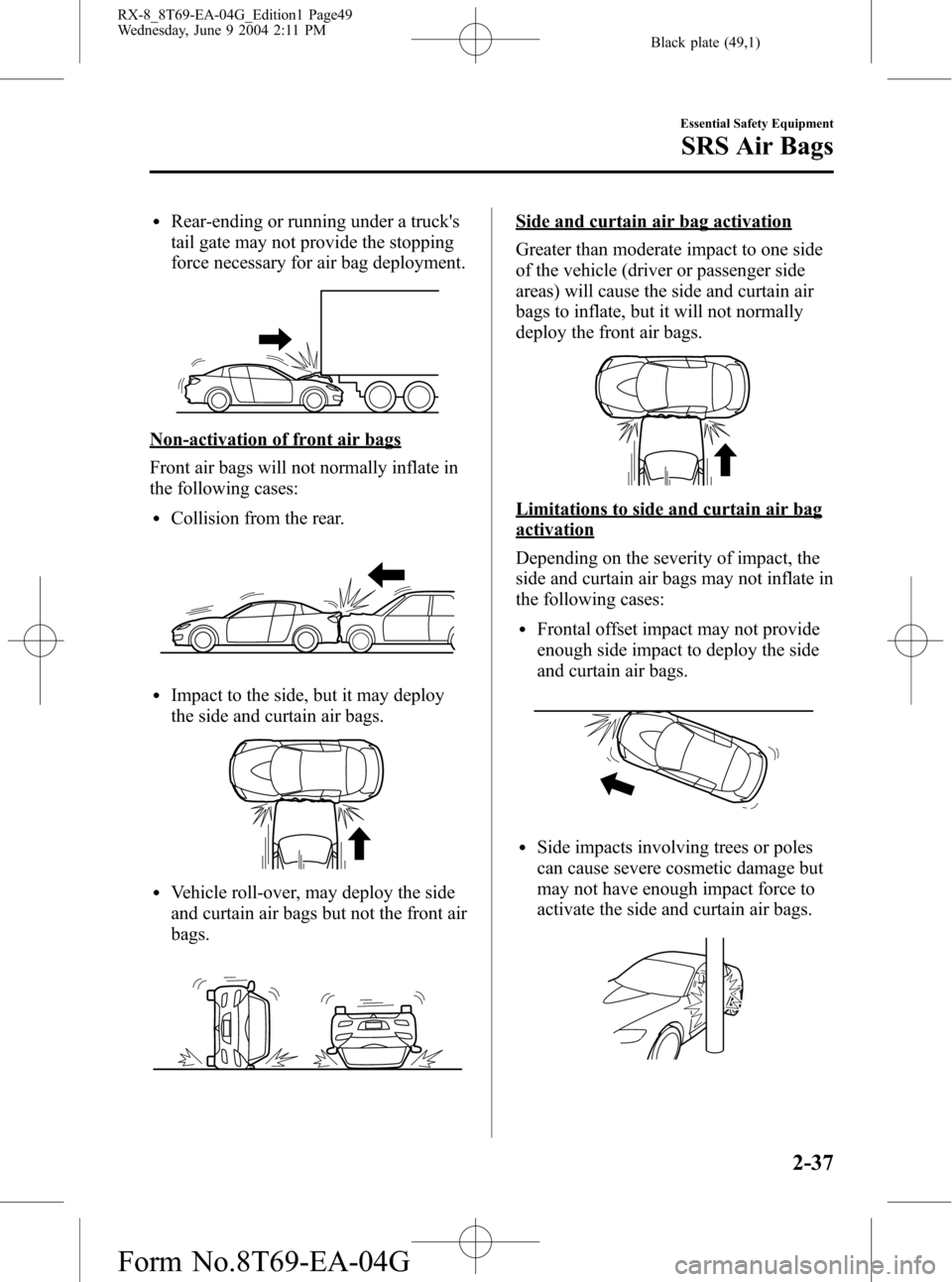
Black plate (49,1)
lRear-ending or running under a truck's
tail gate may not provide the stopping
force necessary for air bag deployment.
Non-activation of front air bags
Front air bags will not normally inflate in
the following cases:
lCollision from the rear.
lImpact to the side, but it may deploy
the side and curtain air bags.
lVehicle roll-over, may deploy the side
and curtain air bags but not the front air
bags.
Side and curtain air bag activation
Greater than moderate impact to one side
of the vehicle (driver or passenger side
areas) will cause the side and curtain air
bags to inflate, but it will not normally
deploy the front air bags.
Limitations to side and curtain air bag
activation
Depending on the severity of impact, the
side and curtain air bags may not inflate in
the following cases:
lFrontal offset impact may not provide
enough side impact to deploy the side
and curtain air bags.
lSide impacts involving trees or poles
can cause severe cosmetic damage but
may not have enough impact force to
activate the side and curtain air bags.
Essential Safety Equipment
SRS Air Bags
2-37
RX-8_8T69-EA-04G_Edition1 Page49
Wednesday, June 9 2004 2:11 PM
Form No.8T69-EA-04G
Page 50 of 364
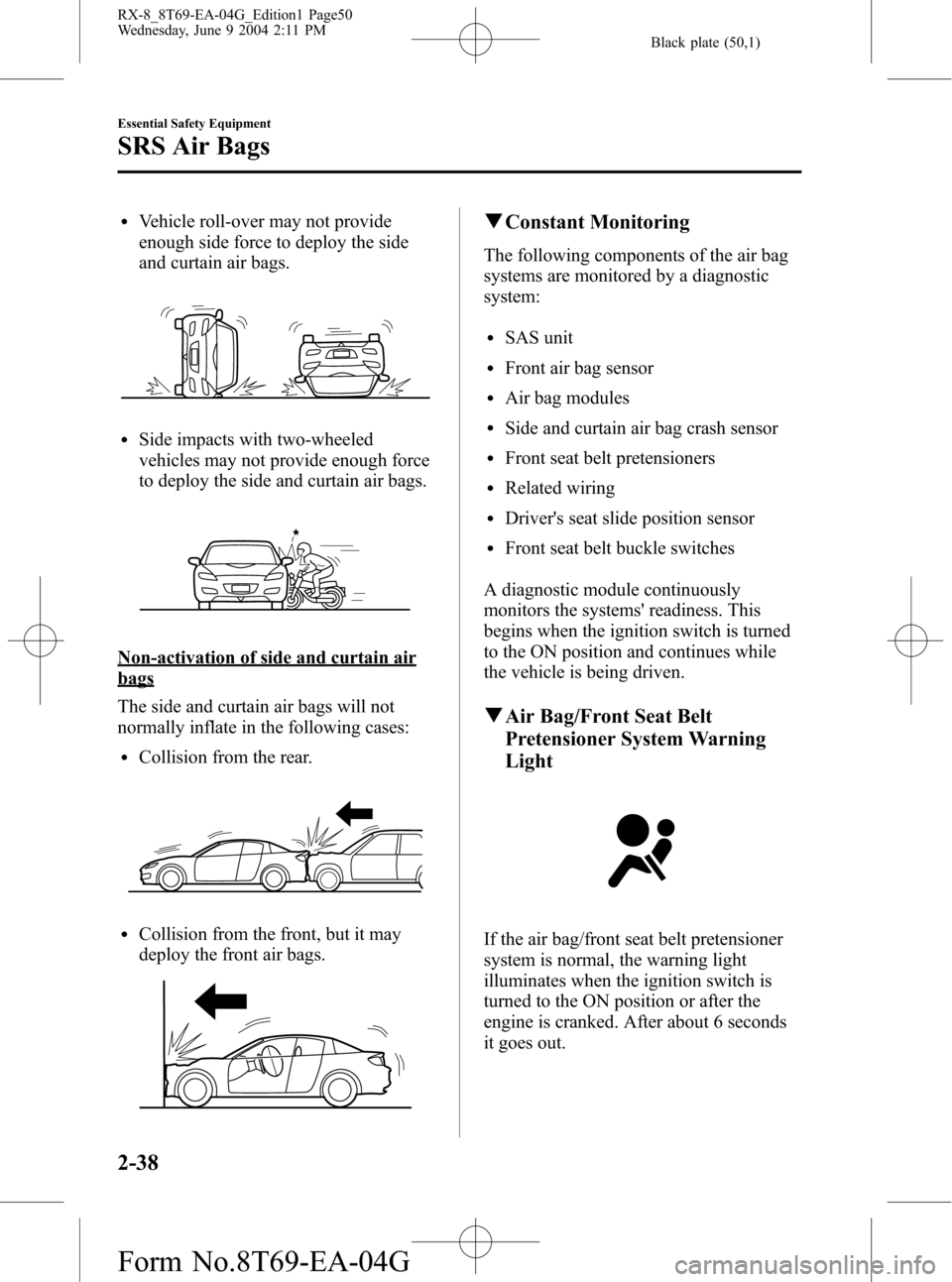
Black plate (50,1)
lVehicle roll-over may not provide
enough side force to deploy the side
and curtain air bags.
lSide impacts with two-wheeled
vehicles may not provide enough force
to deploy the side and curtain air bags.
Non-activation of side and curtain air
bags
The side and curtain air bags will not
normally inflate in the following cases:
lCollision from the rear.
lCollision from the front, but it may
deploy the front air bags.
qConstant Monitoring
The following components of the air bag
systems are monitored by a diagnostic
system:
lSAS unit
lFront air bag sensor
lAir bag modules
lSide and curtain air bag crash sensor
lFront seat belt pretensioners
lRelated wiring
lDriver's seat slide position sensor
lFront seat belt buckle switches
A diagnostic module continuously
monitors the systems' readiness. This
begins when the ignition switch is turned
to the ON position and continues while
the vehicle is being driven.
qAir Bag/Front Seat Belt
Pretensioner System Warning
Light
If the air bag/front seat belt pretensioner
system is normal, the warning light
illuminates when the ignition switch is
turned to the ON position or after the
engine is cranked. After about 6 seconds
it goes out.
2-38
Essential Safety Equipment
SRS Air Bags
RX-8_8T69-EA-04G_Edition1 Page50
Wednesday, June 9 2004 2:11 PM
Form No.8T69-EA-04G